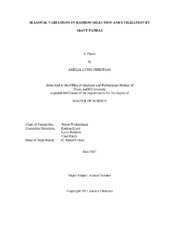| dc.description.abstract | Despite retaining a carnivore’s characteristic simple gastrointestinal tract, giant pandas acquire the majority of their required nutrients from bamboo. The processes that allow giant pandas to meet their nutritional requirements from this high fiber diet are not yet fully understood due to this monogastric species’ limited capability to digest plant structural components. Season dietary shifts in plant part selection have been observed in both wild and captive giant panda populations, and are believed to be an adaptive response to their specialized bamboo diet. We hypothesized that these dietary shifts are driven by temporal changes in the nutritive composition of bamboo and accompanied by changes in digestibility that maximize the absorption of bamboo nutrients in the giant panda. To examine changes in bamboo selection and potential responses in nutrient utilization, five feeding trials were conducted with two captive giant pandas at the Memphis Zoo (July 2014, January, March, May, October 2015).
Both giant pandas exhibited two distinctive culm-preference trials, one shoot-preference trial, and one leaf-preference trial. Despite higher nutritive quality of bamboo leaves, culm was the overall predominant plant part consumed by giant pandas during year. Maximum bamboo culm intake coincided with times of high starch concentration in culm. However, starch and hemicellulose content in culm was relatively low during October, when both giant pandas incorporated considerable amounts of leaves into their diets. Bamboo shoots were preferentially consumed when offered during May, likely due to their reduced proportion of plant part structural compounds (ADF and NDF) and increased CP content. Total dry matter digestibility of bamboo based diets by giant pandas is very low (averaging less than 30%), though giant pandas can apparently access and utilize non-fiber nutrients, such as starch, to a greater extent. When bamboo shoots were included in the diet, giant pandas achieved higher digestion rates for all nutrients. We propose that the basis of giant panda foraging strategy is maximization of digestible energy intake, often from carbohydrate sources, which has applications in the aforementioned areas of giant panda conservation, in addition to management of animals in captive scenarios. | en |


